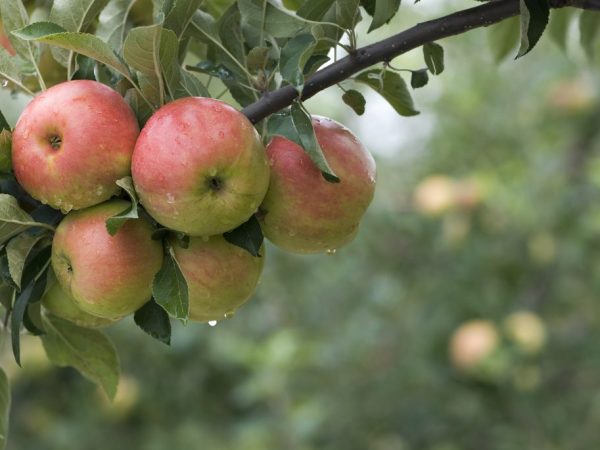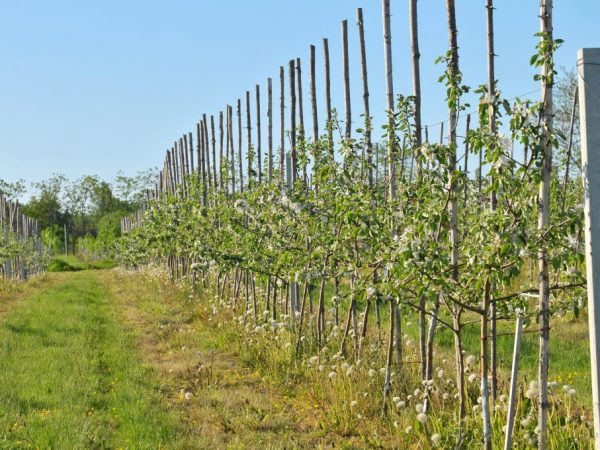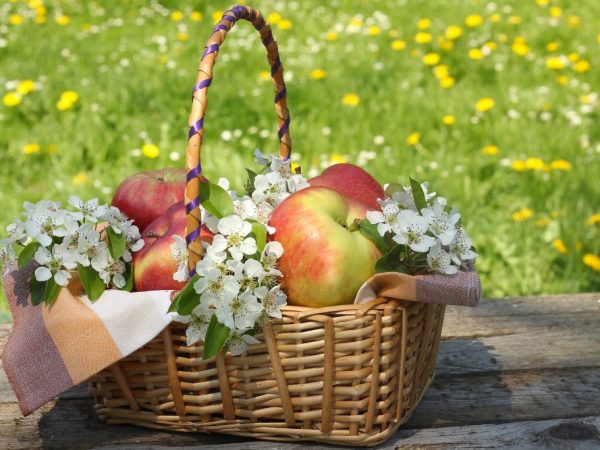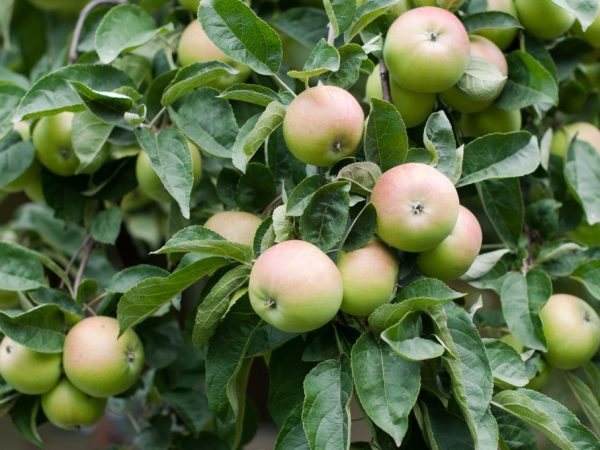Varietal features of the Uslada apple tree
The apple tree Uslada was bred by the breeder Isaev in the middle of the last century. Gardeners have already appreciated all the advantages of this variety. The tree produces delicious, versatile fruits. Observance of the rules of planting and care will help to get a good harvest.

Varietal features of the Uslada apple tree
Characteristic
The tree is medium-sized. The crown of a young apple tree is rounded, becoming more elongated over time. The leaves are ovoid, pointed, and have a bright green color.
The description indicates that the variety is of medium size. The surface is smooth, yellow-green in color with a delicate pink blush. The apples have a sweet taste with berry notes. The pulp is crispy and juicy.
Advantages and disadvantages of the variety
Experienced gardeners distinguish the following advantages of the variety:
- miniature, unpretentious care;
- high yield even under adverse weather conditions;
- high frost resistance;
- good taste and marketability of apples;
- high resistance to fungal diseases and pests.
Apple trees Delight have a high shoot-forming ability. Many call it a disadvantage, because the crown has to be cut more often. Ripe fruits of the variety are very tender, they are not suitable for long-term storage. The variety has no other disadvantages.
Yield
The tree bears its first fruits 4-5 years after planting. The yield is consistently high even with a large amount of precipitation.
According to the description, 60-80 kg of apples can be harvested from one mature tree per season. Indicators depend on the terrain, soil composition, and also on care.
Self-fertility
Delight is a self-fertile variety. Cross-pollination is necessary for the fruit to appear on the tree.
Pollinators should be near the apple tree of this species. Such varieties are used as them - Grushovka, Orlik, Bogatyr, President.
Winter hardiness
Delight belongs to frost-resistant varieties. Even young trees can withstand extreme temperature changes.
In winter, the apple tree tolerates frosts down to -25 ° C. This allows it to be grown in different regions of Russia.
Planting an apple tree

Young seedlings must be tied up
The Uslada apple variety is planted in the last days of April or in the fall, before the beginning of October. The tree needs fertile land. The ideal option is black soil.
Basic landing rules:
- a few days before it, you need to prepare holes with a depth of 60-75 cm; when planting several young trees, the distance between the holes should be at least 4 m;
- loosen the soil in the holes, add compost (10-20 kg per sq. m), superphosphate (25 g per sq. m), potassium and nitrogen fertilizing (10-15 g per sq. m);
- place the seedling in a hole and sprinkle with earth;
- tamp the soil in the near-trunk zone;
- water the seedling abundantly with water;
- after 7 days, cover the near-trunk soil with mulch, water the tree again.
Young trees should be tied to a peg.For the apple tree, you need to select a place protected from drafts.
Care
The apple tree is undemanding to care for. It is necessary to carry out the standard procedures for fruit crops:
- watering. It is necessary to irrigate the seedlings as the upper part of the soil dries. Watering of adult trees after winter begins during the formation of buds, continues until November. Moisturizing frequency - every 14 days, abundance - 15 liters. It is imperative to water the tree at the root;
- top dressing. Ammonium nitrate is added in spring. In autumn, the tree needs phosphorus-potassium mixtures, they are scattered into specially dug grooves around the crown perimeter;
- pruning and crown formation. Due to its high shoot-forming ability, the tree needs pruning. In the spring, before the juices begin to move, remove all shoots that will not bear fruit. Also, cut branches growing inward, old and frozen. The procedure is carried out with a sharp instrument, the cuts must be treated with garden varnish.
In a dry, hot summer, the Uslada apple trees need more frequent watering. After harvesting, before winter, the ground around the trunk must be carefully dug up, potash fertilizers must be applied. It is advised to wrap the apple tree stump with roofing material to protect it from pests.
Features of ripening and fruiting
The variety blooms from mid-May to mid-June. The flowers are very beautiful and fragrant. The first fruiting occurs at 4-5 years.
Apples ripen by mid-August, by which time they have reached their maximum weight and sweet taste. You can harvest the fruits in mid-July. Unripe fruits have a pleasant sour note on the palate.
Harvesting and storage

The late harvest is the sweetest
The entire crop should be harvested by early September. The later the fruits are harvested, the sweeter they are.
Apples are stored for 4-5 months. Ripe fruits can be kept cool and well ventilated until January. Fruits harvested in mid-July may last until March.
You need to store fresh apples on racks covered with straw so that the fruits do not come into contact with each other. You can keep the harvest in wooden boxes, while sheets of cardboard are placed between the fruits.
Pests and diseases
The main advantage of the Uslada apple tree is its resistance to pests and fungal diseases, including scab. But with improper care, the culture can be affected by various ailments and parasites.
Diseases to which the variety is susceptible:
- powdery mildew - affects the bark, leaves, buds, they are first covered with a light, and then brown bloom;
- cytosporosis - damage to the cortex, in which large parts of it die off;
- fruit rot - manifested by massive rotting of apples, they deteriorate and fall to the ground;
- black cancer - affects the bark, leaves and fruits, they become covered with black spots of rot, the bark cracks and turns out.
Insects that attack an apple tree include:
- red mite - gnaws at the leaves, sucking the juice out of them;
- leaf rollers - cover the leaves with a small cobweb, folding them into a tube, damage the buds and buds;
- green aphids - small insects that develop into a huge colony, devour the leaves, leaving a white bloom;
- moth - eats away the pulp and seeds of apples.
There are remedies for each type of pest. "Topaz" and "Hom" are used for fungal diseases. To get rid of insects, insecticides are used.
Damaged areas must be removed and burned away from the garden. To prevent diseases after leaf fall, you need to remove all the leaves from the ground, treat the trees with insecticidal solutions.
Apple tree subspecies

The choice of the type depends on the terrain
There are three subspecies of the Uslada apple tree, each of which needs different care:
- columnar. Needs more careful maintenance, formation of the root system and pruning of the crown. The subspecies is used for growing on an industrial scale;
- on a dwarf rootstock. It is characterized by increased frost resistance, earlier fruiting;
- on a clonal rootstock.It is necessary to use it if you want to give the tree new qualities.
The choice of variety depends on the area and purpose of the apple trees.
Growing regions
Apple trees are grown in many regions of Russia - in the middle lane, in the south and northwest. There are some peculiarities of crop care in different areas.
In the Leningrad Region, it is necessary to reduce the number of irrigations. In Siberia, gardeners recommend growing the variety on a dwarf rootstock. She gets through the harsh winters better. In the suburbs, trees grow without problems. The amount and amount of watering depends on the weather conditions.
Gardeners reviews
Many gardeners have already appreciated the virtues of the apple tree. They note the high yield of the variety. In the southern regions, trees bring their first fruits as early as the 3rd year after planting. In the northwest, according to reviews, fruiting occurs later.
Gardeners also note that the spring rise in the groundwater level almost does not harm apple trees. But varieties on dwarf rootstocks are advised to be planted on a hill. The permissible groundwater level is 1-1.5 m.
Everyone who has grown the Uslada apple variety notes the excellent taste of the fruit. Many people feel raspberry notes in it. Apples are well suited for preservation, making jams, sauces, juices.

